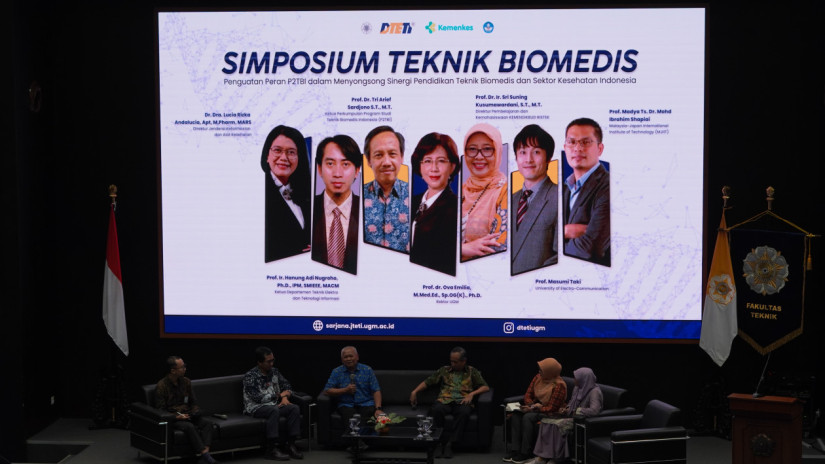
In recent decades, technological advances have transformed the way people understand, diagnose, and treat various medical conditions.
Biomedical engineering, an interdisciplinary field combining engineering principles with biological and medical sciences, is now enhancing healthcare services.
From advanced medical devices to the use of artificial intelligence (AI) in diagnostics, biomedical technology continues to pave the way for innovations that save lives and improve the quality of life worldwide.
Highlighting the great potential of biomedical engineering, the Department of Electrical Engineering and Information Engineering, UGM Faculty of Engineering (FT UGM), held a Biomedical Engineering Symposium on Thursday (Nov. 14) at the Auditorium of Professor Roosseno Soerjohadikoesoemo Building.
The event, themed ‘Strengthening the Role of P2TBI in Fostering Synergy Between Biomedical Engineering Education and Indonesia’s Health Sector,’ aimed to promote collaboration between education and healthcare.
Professor Selo, Dean of FT UGM, noted in his remarks that the biomedical engineering market is projected to experience significant growth by 2030.
He emphasized the great opportunities for Indonesia to contribute globally to health technology innovation.
“The collaboration between biomedical engineering education and the health sector is essential to improving healthcare quality in Indonesia,” he stated.
However, despite the increasing demand for medical devices in Indonesia, the country remains largely dependent on imports, making it crucial to encourage synergy between biomedical engineering education and the healthcare sector.
Professor Tri Arief Sardjono, Chair of the Indonesian Biomedical Engineering Study Association (P2TBI), highlighted two main challenges faced by the domestic medical device industry.
The first is the weak ecosystem for medical device production, from raw materials to supporting industries, and the second is the unclear distinction between the education levels of biomedical technicians (applied bachelors) and biomedical engineers (bachelors).
“Educational institutions must focus on equipping students with the appropriate competencies, as their roles will differ. Competency certification can be facilitated by institutions such as the National Professional Certification Agency (BNSP),” explained Professor Sardjono.
Professor Sri Suning Kusumawardani, Director of Learning and Student Affairs, Directorate General of Higher Education, stressed the importance of artificial intelligence literacy for biomedical engineering students to face global challenges, particularly in ethics and security.
She also emphasized the need to distribute biomedical engineering study programs more evenly across the country so that this sector’s contributions can be felt throughout Indonesia.
“We need to strengthen technological literacy, especially AI, to respond to changes in the job landscape influenced by automation. Education must be responsive to global trends,” she said.
Professor of Biomedical Engineering at FT UGM, Hanung Adi Nugroho, underscored the urgency of forming professional associations to support biomedical engineers and ensure their competencies are recognized through certifications such as the Electromedical Registration Certificate (STR-E).
“This formal certification guarantees the competency standards of biomedical engineering graduates in line with the needs of healthcare institutions,” he remarked.
In addition to exploring the challenges and opportunities in the future of biomedical engineering, the event featured distinguished guest lectures. Masumi Taki, Associate Professor at the University of Electro-Communications (UEC) Tokyo, presented on the development of Biomolecular Targeted Covalent Inhibitors (BioTCI).
Meanwhile, Ts. Dr. Mohd Ibrahim Shapiai, Associate Professor and Director of CAIRO at Universiti Teknologi Malaysia (UTM), shared valuable insights into biomedical engineering curricula and the potential for cross-border collaboration in educational development.
Author: Triya Andriyani
Post-editor: Afifudin Baliya
Photo: FT UGM

